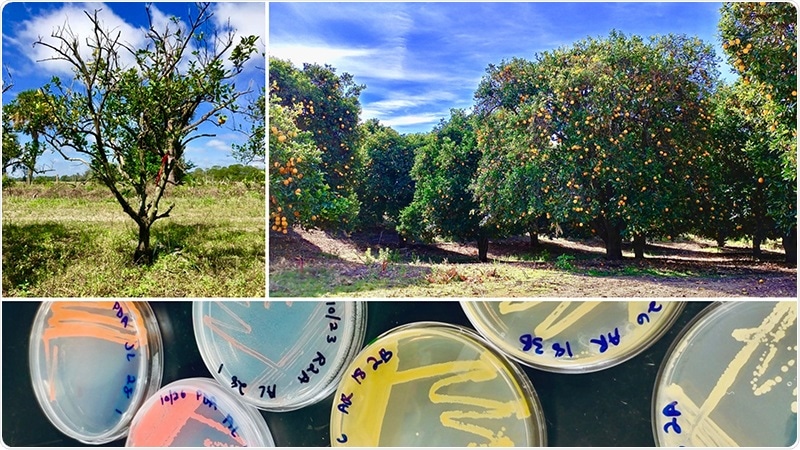While humans are facing the raging COVID-19 pandemic, the citrus industry is attempting to control its own pernicious disease, Huanglongbing (HLB), which is also called citrus greening disease.

Orange fields and lab work. Image Credit: Dr Nichole Ginnan.
Scientists view HLB as the most destructive citrus disease in the globe. In the last 10 years, the Florida citrus industry has been annihilated by this disease, which reduced the production of oranges meant for juice and other products by as much as 72%.
The microorganism called candidatus Liberibacter asiaticus (CLas) is associated with the HLB disease. This pathogen dwells in the phloem of the tree and, similar to several plant pathogens, is transferred by insects at the time of the feeding events.
While the disease may progress slowly, it is quite catastrophic. The disease causes symptoms that start with yellow shoots, blotchy leaves, and stunting, and then progress into poor quality fruit, yield decline, and ultimately death.
At present, controlling the insect vector is the only option available to citrus growers to protect their crops from the HLB disease. As such, many scientists are looking for ways to control the disease, using different strategies like antibiotics, pesticides, and CLas-sniffing dogs. Yet another strategy is figuring out the plant microbiome—an interesting new frontier in the management of plant disease.
Dr Caroline Roper and Dr Nichole Ginnan, the first author of the study from the University of California, Riverside headed a massive research alliance that sought to investigate the role of the microbiome in the progression of HLB disease. The team’s new article, titled “Disease-Induced Microbial Shifts in Citrus Indicate Microbiome-Derived Responses to Huanglongbing,” has been published in the Phytobiomes Journal.
The new article goes beyond the single-snapshot view of microbial biodiversity which is a characteristic of microbiome research. The researchers adopted a holistic approach to study the interactions between plants and microbes and successfully captured many snapshots across a period of three years and three separate types of tissues (leaves, stems, and roots).
What is truly fascinating about this study is the application of amplicon (16S and ITS) sequencing to record the highly dynamic and complex role of the microbiome (both fungal and bacterial) as it shifts over the course of the progression of HLB disease.
Ginnan and team concluded that HLB disease produced a diseased-induced shift of the microbiome of the tree. In particular, the investigators demonstrated that the diversity of the microbes increases as the disease progresses.
The researchers further examined this trend and found that the increased diversity was linked to an increase in saprophytic (dead tissue-feeding) and putative pathogenic (disease-causing) microorganisms.
During the early phases of the disease, the researchers observed a substantial reduction in the number of beneficial microorganisms. The authors highlighted one such beneficial microorganisms, called Arbuscular mycorrhizal fungi (AMF), that showed a significant decline in relative abundance.
The reduction of crucial microbial species at the time of the disease may pave the way for other microorganisms to invade. Some resources may become more or less available, enabling different microorganisms to thrive.
Drs Roper and Ginnan proposed that when HLB disease starts, this depletion event activates a surge of beneficial microorganisms to come to the aid of the citrus tree. And according to them, the microorganisms are probably triggering an immune reaction to guard the host.
As the disease spreads, the citrus tree and its microbiome progress to change. Dr Ginnan, the study’s lead author, observed that severely diseased roots contained an abundance of saprophytic and parasitic microbes. The abundance of these microorganisms may play a role in disease progression and root decline, which is one of the side effects of HLB disease.
Trees that did not progress into severe disease, or survivor trees, had also an exclusive microbial profile. Such trees were enriched with putative symbiotic microorganisms such as Aureobasidium sp and Lactobacillus sp. This finding led the team to detect specific microorganisms that were linked to slower progression of the disease.
Dr Ginnan added that their “aha” moment during the study was in the data analysis.
Originally we were looking for taxa that increased and decreased in relative abundance as disease rating increased. Our differential abundance analysis ended up revealing clear enrichment patterns replicated in multiple taxa.”
Dr Nichole Ginnan, Study First Author, University of California
This is the exact moment they started to design the distinct patterns they were seeing into a wider disease model.
The study is the basis for upcoming collaborations and projects that the authors are looking forward to continue to develop. The researchers are motivated by the possible function of the microbiome to control crop diseases.
In the days to come, they hope that such findings and a better interpretation of beneficial microorganisms can help determine a microbiome-mediated treatment strategy to guard crops against various diseases, including HLB. The model developed by the team can also be used to understand the diseases of other tree crop systems.
Source:
Journal reference:
Ginnan, N. A., et al. (2021) Disease-Induced Microbial Shifts in Citrus Indicate Microbiome-Derived Responses to Huanglongbing Across the Disease Severity Spectrum. Phytobiomes Journal. doi.org/10.1094/PBIOMES-04-20-0027-R.